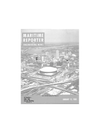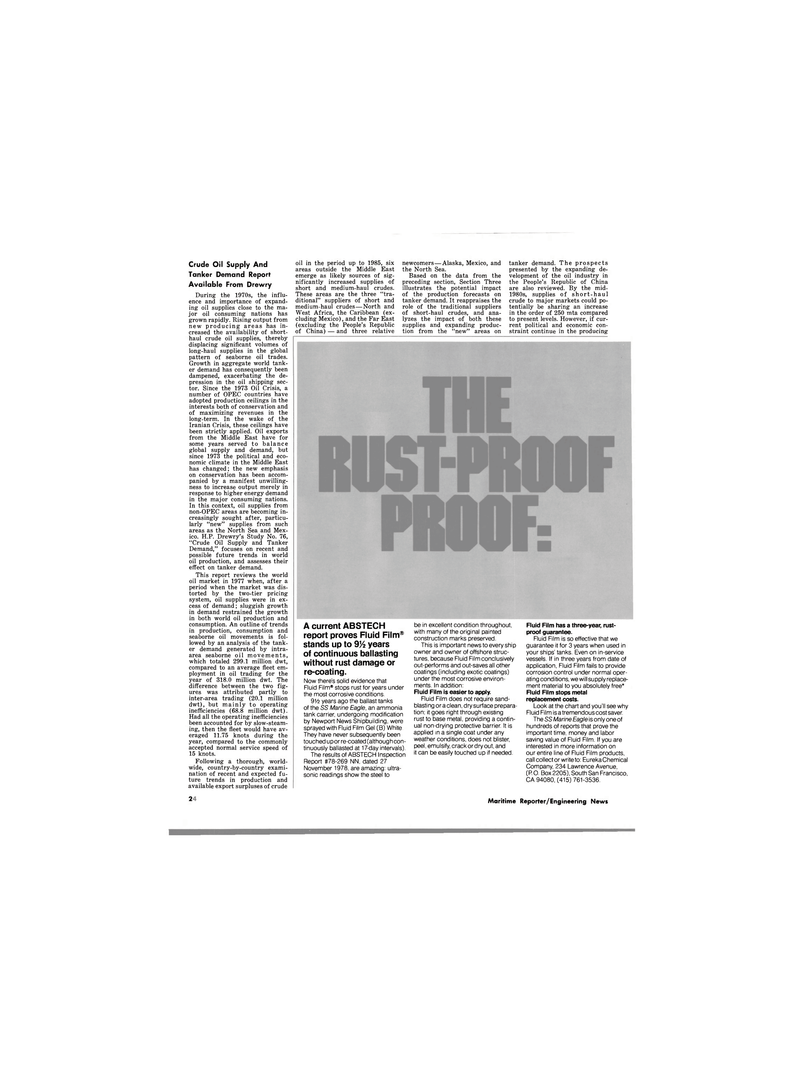
Page 3rd Cover: of Maritime Reporter Magazine (January 15, 1980)
Read this page in Pdf, Flash or Html5 edition of January 15, 1980 Maritime Reporter Magazine
oil in the period up to 1985, six areas outside the Middle East emerge as likely sources of sig- nificantly increased supplies of short and medium-haul crudes.
These areas are the three "tra- ditional" suppliers of short and medium-haul crudes — North and
West Africa, the Caribbean (ex- cluding Mexico), and the Far East (excluding the People's Republic of China) — and three relative newcomers—Alaska, Mexico, and the North Sea.
Based on the data from the preceding section, Section Three illustrates the potential impact of the production forecasts on tanker demand. It reappraises the role of the traditional suppliers of short-haul crudes, and ana- lyzes the impact of both these supplies and expanding produc- tion from the "new" areas on tanker demand. The prospects presented by the expanding de- velopment of the oil industry in the People's Republic of China are also reviewed. By the mid- 1980s, supplies of short-haul crude to major markets could po- tentially be sharing an increase in the order of 250 mta compared to present levels. However, if cur- rent political and economic con- straint continue in the producing
Crude Oil Supply And
Tanker Demand Report
Available From Drewry
During the 1970s, the influ- ence and importance of expand- ing oil supplies close to the ma- jor oil consuming nations has grown rapidly. Rising output from new producing areas has in- creased the availability of short- haul crude oil supplies, thereby displacing significant volumes of long-haul supplies in the global pattern of seaborne oil trades.
Growth in aggregate world tank- er demand has consequently been dampened, exacerbating the de- pression in the oil shipping sec- tor. Since the 1973 Oil Crisis, a number of OPEC countries have adopted production ceilings in the interests both of conservation and of maximizing revenues in the long-term. In the wake of the
Iranian Crisis, these ceilings have been strictly applied. Oil exports from the Middle East have for some years served to balance global supply and demand, but since 1973 the political and eco- nomic climate in the Middle East has changed; the new emphasis on conservation has been accom- panied by a manifest unwilling- ness to increase output merely in response to higher energy demand in the major consuming nations.
In this context, oil supplies from non-OPEC areas are becoming in- creasingly sought after, particu- larly "new" supplies from such areas as the North Sea and Mex- ico. H.P. Drewry's Study No. 76, "Crude Oil Supply and Tanker
Demand," focuses on recent and possible future trends in world oil production, and assesses their effect on tanker demand.
This report reviews the world oil market in 1977 when, after a period when the market was dis- torted by the two-tier pricing system, oil supplies were in ex- cess of demand; sluggish growth in demand restrained the growth in both world oil production and consumption. An outline of trends in production, consumption and seaborne oil movements is fol- lowed by an analysis of the tank- er demand generated by intra- area seaborne oil movements, which totaled 299.1 million dwt, compared to an average fleet em- ployment in oil trading for the year of 318.0 million dwt. The difference between the two fig- ures was attributed partly to inter-area trading (20.1 million dwt), but mainly to operating inefficiencies (68.8 million dwt).
Had all the operating inefficiencies been accounted for by slow-steam- ing, then the fleet would have av- eraged 11.75 knots during the year, compared to the commonly accepted normal service speed of 15 knots.
Following a thorough, world- wide, country-by-country exami- nation of recent and expected fu- ture trends in production and available export surpluses of crude
A current ABSTECH report proves Fluid Film® stands up to 91/2 years of continuous ballasting without rust damage or re-coating.
Now there's solid evidence that
Fluid Film® stops rust for years under the most corrosive conditions. 91/2 years ago the ballast tanks of the SS Marine Eagle, an ammonia tank carrier, undergoing modification by Newport News Shipbuilding, were sprayed with Fluid Film Gel (B) White
They have never subsequently been touched upor re-coated (althoughcon- tinuously ballasted at 17-day intervals).
The results of ABSTECH Inspection
Report #78-269 NN, dated 27
November 1978, are amazing: ultra- sonic readings show the steel to be in excellent condition throughout, with many of the original painted construction marks preserved.
This is important news to every ship owner and owner of offshore struc- tures, because Fluid Film conclusively out-performs and out-saves all other coatings (including exotic coatings) under the most corrosive environ- ments. In addition:
Fluid Film is easier to apply.
Fluid Film does not require sand- blasting or a clean, dry surface prepara- tion: it goes right through existing rust to base metal, providing a contin- ual non-drying protective barrier. It is applied in a single coat under any weather conditions, does not blister, peel, emulsify, crack or dry out, and it can be easily touched up if needed.
Fluid Film has a three-year, rust- proof guarantee.
Fluid Film is so effective that we guarantee it for 3 years when used in your ships' tanks. Even on in-service vessels. If in three years from date of application, Fluid Film fails to provide corrosion control under normal oper- ating conditions, we will supply replace- ment material to you absolutely free*
Fluid Film stops metal replacement costs.
Look at the chart and you'll see why
Fluid Film is a tremendous cost saver.
The SS Marine Eagle is only one of hundreds of reports that prove the important time, money and labor saving value of Fluid Film. If you are interested in more information on our entire line of Fluid Film products, call collector write to: EurekaChemical
Company, 234 Lawrence Avenue, (P. O. Box 2205), South San Francisco,
CA 94080, (415) 761-3536. 52 ZIDELL Maritime Reporter/Engineering News

 23
23

 4th Cover
4th Cover
